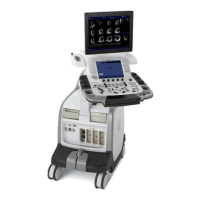GE H
EALTHCARE
D
IRECTION
GA091568, R
EVISION
5 VIVID E9 S
ERVICE
M
ANUAL
5 - 16 Section 5-3 - VIVID E9 overview
5-3-9-6 Power Doppler
A real-time two dimensional cross-section of blood flow is displayed. The 2D cross-section is presented
as a full color display, with various colors being used to represent the power in blood flow echoes. Often,
to provide spatial orientation, the full color blood flow cross-section is overlaid on top of the gray scale
cross-section of soft tissue structure (2D echo). For each pixel in the overlay, the decision of whether to
display color (Doppler power), gray scale (echo) information or a blended combination is based on the
relative strength of return echoes from the soft-tissue structures and from the red blood cells. A high
pass filter (wall filter) is used to remove the signals from stationary or slowly moving structures. Tissue
motion is discriminated from blood flow by assuming that blood is moving faster than the surrounding
tissue, although additional parameters may also be used to enhance the discrimination. The power in
the remaining signal after wall filtering is then averaged over time (persistence) to present a steady state
image of blood flow distribution. Power Doppler can be used in combination with 2D and Spectral
Doppler modes as well as with 4D mode.
5-3-9-7 Tissue Velocity Imaging
The Tissue Color Doppler Imaging is used for color encoded evaluation of heart movements. The Tissue
Velocity Imaging image provides information about tissue motion direction and velocity.
5-3-9-8 Pulsed (PW) Doppler
PW Doppler processing is one of two spectral Doppler modalities, the other being CW Doppler. In
spectral Doppler, blood flow is presented as a scrolling display, with flow velocity on the Y-axis and time
on the X-axis. The presence of spectral broadening indicates turbulent flow, while the absence of
spectral broadening indicates laminar flow. PW Doppler provides real time spectral analysis of pulsed
Doppler signals. This information describes the Doppler shifted signal from the moving reflectors in the
sample volume. PW Doppler can be used alone but is normally used in conjunction with a 2D image
with an M-line and sample volume marker superimposed on the 2-D image indicating the position of the
Doppler sample volume. The sample volume size and location are specified by the operator. Sample
volume can be overlaid by a flow direction cursor which is aligned, by the operator, with the direction of
flow in the vessel, thus determining the Doppler angle. This allows the spectral display to be calibrated
in flow velocity (m/sec.) as well as frequency (Hz). PW Doppler also provides the capability of
performing spectral analysis at a selectable depth and sample volume size. PW Doppler can be used
in combination with 2D and Color Flow modes.
5-3-9-9 4D Imaging
• Real-time, non-gated 4D imaging
The 4D probes on the Vivid E9 enables real-time, non-gated 4D tissue and color imaging. The
volume data is displayed in real-time with volume rendering techniques for visualization of valves
and structures.
• Real-time, gated 4D imaging
The 4D probes on the Vivid E9 enables the acquisition of larger tissue/color volumes with ECG
gated acquisition. The data acquired is displayed in real-time so that the user can control the quality
of the data acquired throughout the scanning process.
For more information on 4D, please refer to the VIVID E9 User Manual/User Guide.

